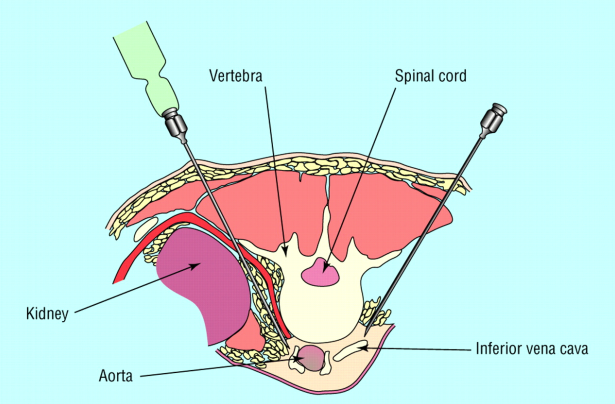Coeliac Plexus Block
What is the coeliac plexus?

The coeliac plexus is another name for the solar plexus. The coeliac plexus is a group of nerves that supply the organs in the upper abdomen, especially the liver, pancreas and stomach. It lies in front of the spine.
What is coeliac plexus block and why is it helpful?
A coeliac plexus block involves injecting either local anaesthetic or nerve destroying solutions around the solar plexus (coeliac plexus) in your abdomen. By doing this the solar plexus is anaesthetised. This may reduce or eliminate your pain. If the initial block is successful, then it may be repeated. Why is it performed? Pain from the organs of the upper abdomen may be improved by anaesthetising or destroying the coeliac plexus.
How is it performed?
The procedure will have been discussed with you by your pain doctor and you will sign a consent form. The coeliac plexus block is performed as a day case procedure. You will be admitted to Jefferson Ward and seen by one of the pain doctors who will ask if you have any further questions. Before this injection you will need to change into a hospital gown. For this injection you will lie on your tummy. This injection is performed under X-ray control. A drip will be inserted in the back of your hand and relaxation medication will be given. You will be given a fluid drip to prevent any fall in blood pressure, which may be caused by this injection. We will monitor your breathing and circulation. Your back will be cleansed with antiseptic solution. Local anaesthetic is injected into the skin to numb the area. There may be some discomfort in the back at the time of the injection. Two needles are inserted into the coeliac plexus through your back. If the coeliac plexus is to be numbed then local anaesthetic will be injected down both needles. If the coeliac plexus is to be destroyed then alcohol will be injected down both needles. Alcohol does not have a licence to be used in this way, although it is commonly used.
If you take blood thinning medications (Eg. Warfarin, Clopidogrel, Aspirin etc.) or medications for diabetes, your pain doctor will instruct you on how and when to take them before the procedure.
What happens after the procedure?
Immediately following the procedure you will go to the recovery area for a short period, before being transferred back to Jefferson ward.
You will be discharged from here, a minimum of 1 hour after your procedure. Please ensure someone is available to collect you from the ward as you will not be allowed to drive yourself after this procedure.
What are the side effects?
- This injection may drop your blood pressure, although it is not a problem if your fluid intake is normal. You should take extra care when getting out of bed for the first time after this injection.
- You may have diarrhoea after this injection and this is relatively common.
- Pain and bruising at the injection site. This is related to needles used to block or destroy coeliac plexus. This settles in a day or two.
- As the injection site is very close to major blood vessels there is a rare risk of internal bleeding.
- This injection may not relieve your pain or may last only for a very short duration.
- Injection of alcohol may be rarely associated with neuralgia (burning groin pain), paraplegia (leg weakness) or failure of ejaculation.
- Last Updated:01 April 2020
- Review Date:30 April 2024
- Author:The pain team
- Summary:
The coeliac plexus is a group of nerves that supply the organs in the upper abdomen, especially the liver, pancreas and stomach. It lies in front of the spine.